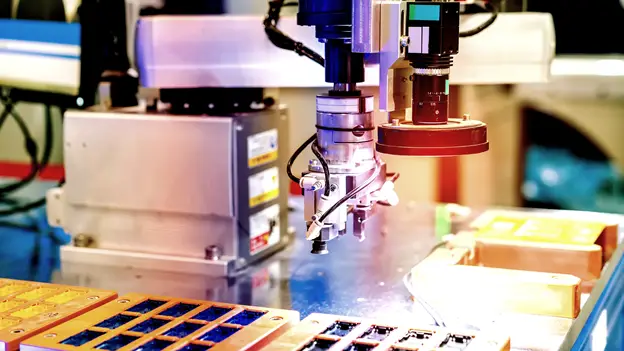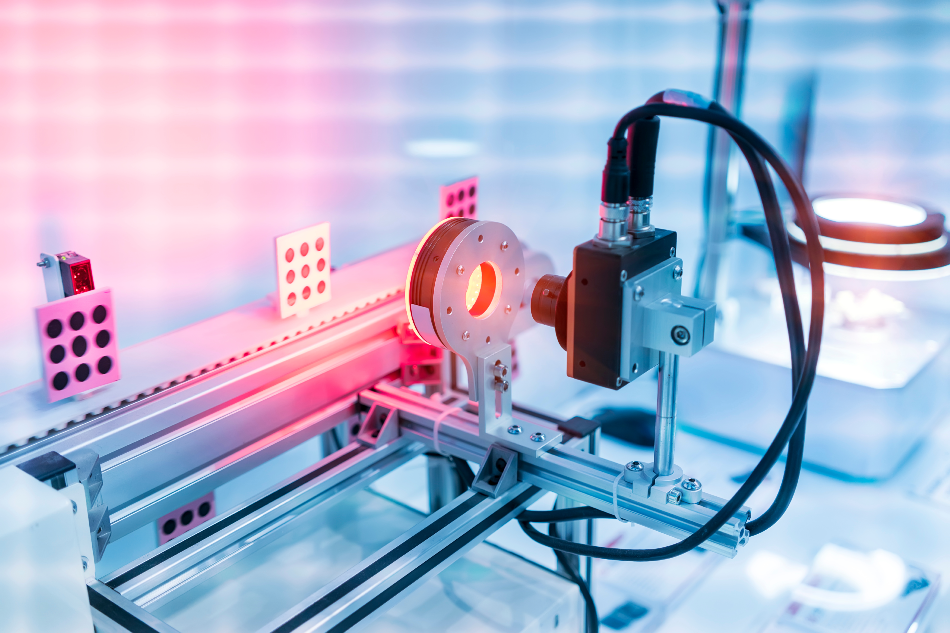Integrating robotic vision with AI and IoT systems
Why Robotic Vision Is Necessary for Progressing Accuracy in Production Industries
Robotic vision has become a crucial component in modern-day manufacturing. It empowers makers to examine visual information with exceptional precision. This capacity enhances high quality control and minimizes the chance of flaws. As industries undertaking for higher effectiveness, recognizing the ins and outs of robotic vision comes to be essential. The interplay in between technology and functional processes increases important concerns concerning future improvements and their ramifications. What exists in advance for accuracy in production?
Understanding Robotic Vision Modern Technology

Enhancing High Quality Control With Robotic Vision

Boosting Functional Effectiveness With Automation

Automating manufacturing processes through robotic vision significantly enhances production rate, enabling for quicker turnaround times. This modern technology likewise reduces error rates, making certain higher precision in operations. In addition, streamlined resource management is accomplished, leading to extra effective use products and labor.
Improved Manufacturing Speed
While the combination of robotic vision in manufacturing has transformed operational procedures, its most considerable benefit lies in boosted manufacturing speed. By using innovative picture handling and real-time information analysis, robotic vision systems can quickly determine and respond to manufacturing needs. This sped up responsiveness gets rid of hold-ups generally associated with hands-on assessment and decision-making procedures. In addition, these systems can run constantly without fatigue, guaranteeing that assembly line maintain high throughput. The ability to detect and attend to concerns immediately better enhances workflows, enabling manufacturers to maximize result levels (optical fibre diameter analyser). Firms profit from reduced cycle times and raised productivity, positioning them competitively in the market. Enhanced production speed, driven by robotic vision innovation, inevitably results in boosted operational effectiveness throughout the manufacturing landscape
Minimized Mistake Fees
As manufacturing speed boosts, maintaining precision comes to be extremely important in making processes. Robotic vision systems significantly contribute to lowered mistake prices by providing accurate dimensions and real-time evaluations. These innovative systems make use of high-resolution cameras and sophisticated algorithms to identify problems, misalignments, or inconsistencies in products during assembly. By automating quality assurance, producers can quickly recognize and remedy concerns that human inspectors could ignore. This not only reduces waste but also enhances total product high quality. In addition, the assimilation of robotic vision lowers irregularity in production, making certain that each thing fulfills rigorous requirements. Subsequently, makers experience less pricey recalls and boosted client satisfaction, ultimately resulting in a more effective and profitable operational version.
Structured Resource Management
Effective source administration is important for making the most of functional effectiveness in production, particularly when incorporated with robotic vision systems. These systems enhance the capacity to keep an eye on and allot resources accurately, making sure that products and labor are made use of successfully. By employing advanced aesthetic technologies, producers can determine ineffectiveness in real time, lowering waste and enhancing manufacturing timelines. Additionally, robotic vision allows precise stock tracking, minimizing the danger of overstocking or stockouts. Automation of these procedures not only simplifies procedures yet likewise enables human employees to concentrate on higher-value jobs, fostering advancement and efficiency. Because of this, companies can attain considerable expense savings while maintaining top quality criteria, eventually placing themselves a lot more competitively in the industry.

Minimizing Human Error in Production Processes
Human error remains a considerable challenge in producing processes, typically causing expensive errors and inadequacies. In environments where accuracy is paramount, also minor gaps in judgment can result in malfunctioning items or delays in production schedules. Robotic vision systems can mitigate these threats by supplying precise and consistent surveillance of producing operations. By automating tasks such as quality assurance and production line assessments, these systems decrease the dependence on human oversight, thus lessening the potential for errors.Moreover, robotic vision modern technology improves data precision, enabling real-time changes based upon visual feedback. This ability guarantees that any kind of discrepancies from established standards are immediately identified and dealt with, even more reducing the possibility of blunders. As producers progressively take on robotic vision, they can expect not just to enhance precision and efficiency yet also to cultivate a safer working atmosphere by reducing the stress on human operators.
The Function of Expert System in Robotic Vision
Man-made knowledge significantly improves robotic vision by utilizing machine understanding algorithms and progressed picture processing strategies. These technologies make it possible for robots to interpret aesthetic data with better accuracy, boosting both performance and accuracy in manufacturing setups. Because fibre testing equipment of this, the assimilation of AI into robotic vision systems stands for a pivotal advancement in automation.
Artificial Intelligence Algorithms
Artificial intelligence formulas are changing robotic vision in production by allowing equipments to interpret and analyze visual data with amazing precision. These formulas permit robotics to gain from huge datasets, adjusting to brand-new situations and boosting their efficiency gradually. By leveraging strategies such as monitored and unsupervised knowing, robotic systems can determine patterns and abnormalities in real-time, which enhances high quality control and minimizes waste. Furthermore, artificial intelligence promotes far better decision-making procedures, enabling robots to optimize their activities based on discovered experiences. As these algorithms advance, they equip robotic vision systems to execute progressively complicated tasks, inevitably driving performance and precision in manufacturing procedures. The assimilation of artificial intelligence as a result plays a critical role in the advancement of robotic vision modern technology.
Picture Processing Techniques
Enhancing the capabilities of robotic vision, image processing methods play an essential duty in allowing systems to analyze visual information successfully. These strategies entail formulas that improve picture high quality, extract appropriate functions, and recognize patterns within aesthetic information. By utilizing techniques such as edge discovery, segmentation, and things recognition, robotic systems can recognize and classify components with exceptional precision. The integration of synthetic knowledge further amplifies these methods, permitting adaptive learning and boosted decision-making in vibrant atmospheres. Because of this, robotic vision systems can not just discover problems however additionally maximize procedures, resulting in raised efficiency and accuracy in manufacturing. As a result, the continual development of picture handling techniques continues to be crucial to the advancement of robotic vision in commercial applications.
Future Fads in Robotic Vision for Production Industries
As industries significantly prioritize effectiveness and accuracy, the development of robotic vision innovation is readied to change manufacturing procedures substantially. Future patterns indicate substantial developments in man-made knowledge and device discovering combination within robotic vision systems. These enhancements will certainly improve real-time decision-making abilities, enabling robotics to adjust to differing conditions autonomously. The fostering of 3D vision systems is anticipated to increase, offering even more accurate spatial recognition and item recognition. Cooperations in between robotics and human employees may additionally advance, with sophisticated vision systems promoting much safer and extra reliable communications. Furthermore, the use of side computer will likely enable faster information processing, lowering latency and enhancing functional responsiveness. As these patterns unfold, the manufacturing market stands to take advantage of enhanced quality control, minimized waste, and structured process, ultimately causing raised competition in a rapidly altering market.
Frequently Asked Inquiries
Exactly How Does Robotic Vision Differ From Typical Maker Vision Systems?
Robotic vision integrates sophisticated algorithms and real-time handling, enabling vibrant analysis and interaction with atmospheres. On the other hand, standard machine vision mostly concentrates on fixed photo capture and analysis, limiting versatility and responsiveness in complex manufacturing circumstances.
What Industries Benefit A Lot Of From Robotic Vision Technology?
Various sectors benefit considerably from robotic vision modern technology, consisting of auto, electronic devices, and food handling. These industries take advantage of improved accuracy, effectiveness, and versatility, eventually improving production top quality and reducing functional prices via advanced automation services.
Can Robotic Vision Solutions Be Integrated With Existing Manufacturing Tools?
Robotic vision systems can certainly be incorporated with existing production tools. This integration enhances functional performance, allowing for seamless collaboration in between traditional equipment and progressed visual technology, ultimately improving total production processes and end results.
What Are the Prices Associated With Carrying Out Robotic Vision Solutions?
The expenses linked with applying robotic vision solutions differ considerably, affected by factors such as system intricacy, called for software, hardware parts, integration with present equipment, and recurring upkeep costs, inevitably affecting overall return on investment.
Just how Do Upkeep and Assistance for Robotic Vision Solutions Work?
Maintenance and assistance for robotic vision systems include normal software program updates, equipment evaluations, and troubleshooting. optical fibre diameter analyser. Suppliers typically supply solution agreements, guaranteeing prompt support and minimizing downtime to keep peak performance and integrity in industrial applications